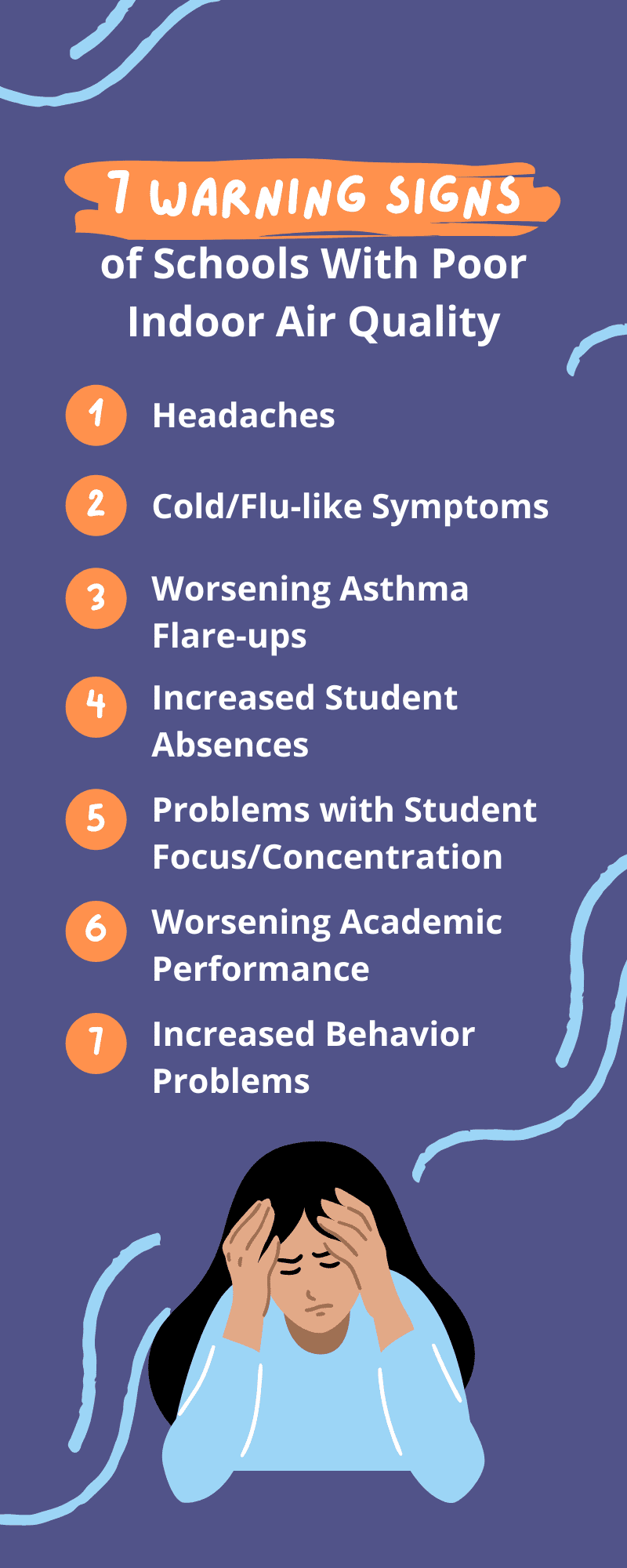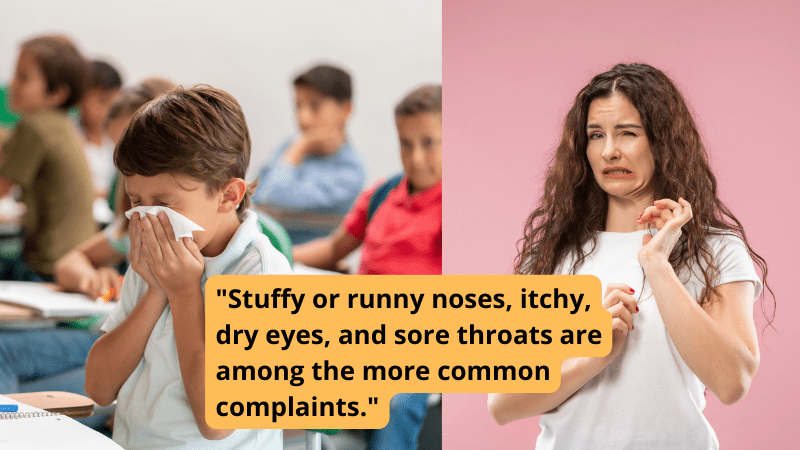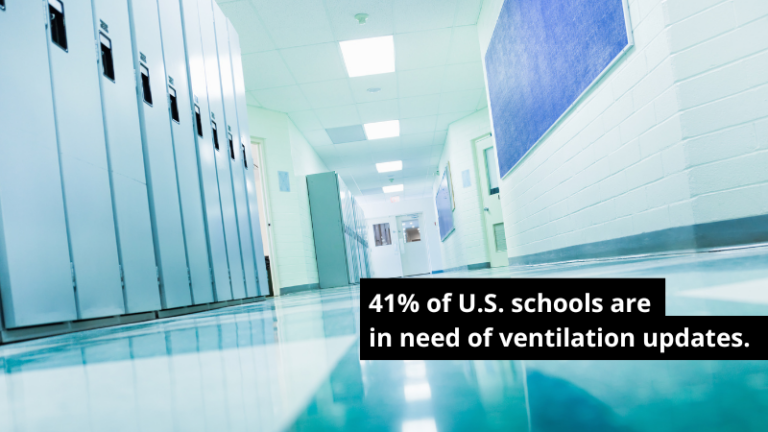After spending the past few years trying to keep our students (and ourselves!) safe from COVID-19 in school, we know just how crucial our school’s indoor air quality is to student and teacher health. But, what happens if it isn’t up to par? And how can we tell? Here are 7 symptoms you might frequently see if your school’s indoor air quality isn’t where it should be:

1. Students and staff are complaining about headaches
Headaches are one of the most common symptoms of poor indoor air quality (IAQ). The National Headache Foundation identified this link, pointing to studies tying an increase in headaches to time spent in an “uncomfortable air environment.” This symptom is often more prevalent among girls and women. However, they’re also one of the most common health complaints reported by children and teens. Because of this, headaches alone might not indicate an air quality issue. But, if the school nurse is treating more student headaches than normal, the school’s indoor air quality might be to blame.
2. Classes are going through tissues at lightning speed
Specific concentrations of pollutants such as mold, dust, and airborne fungi have been linked to symptoms that mirror more common illnesses like colds and cases of flu. Stuffy or runny noses, itchy, dry eyes, and sore throats are among the more common complaints. Additionally, Volatile Organic Compounds (VOCs), gas emissions released by things like paint, furniture or carpet, or cleaning products commonly used in schools, can also exacerbate these symptoms if not properly dealt with by a school’s indoor air quality plan.
3. Students with asthma are really struggling
An average of one out of every 10 school-age children now has asthma. And that number is growing rapidly, especially among preschool-age children. Because of this, students with asthma are more susceptible to breathing problems associated with poor IAQ. If you are noticing an increase of asthma-related symptoms or flare-ups, or if your students with asthma are frequently absent, it may be time to look into your school’s indoor air purifier plan.
4. The student absentee list keeps growing
As was discussed early, a poor IAQ has been linked to increases in absenteeism among students with asthma. But they are not the only ones who miss school due to air quality issues. Respiratory infections, allergies, and adverse reactions from exposure to chemicals used in classrooms are all symptoms of poor IAQ that affect student attendance.
5. Keeping kids focused and on-task is more challenging than ever
While numerous factors impact student focus and concentration, your school’s indoor air quality is undeniably among them. Elevated CO2 levels have been tied to feelings of confusion, fatigue, or distractibility. And because children breathe in more airborne pollutants than adults in the same environment due to their breathing rates, students are more likely to be impacted in this way than the adults in their building might be. Additionally, as students deal with the other symptoms commonly associated with poor IAQ, their ability to focus on their learning becomes increasingly difficult.
6. Grades aren’t where they should be
As our list goes on, we continue to move away from physical symptoms into academic and behavioral ones. Several studies have shown “significant declines in test scores” when students tested in rooms with high levels of airborne particulates. For our youngest students, there is evidence that poor IAQ negatively affects school readiness. It has also been shown to decrease critical thinking skills and decision making. Conversely, good IAQ is accompanied by an increase in students’ academic performance, which should provide an excellent reason to take your school’s indoor air quality plan seriously.
7. Class time is being taken up by behavior issues
This one surprised me, but growing scientific data does seem to back it up. One of the most insidious aspects of poor indoor air quality is how often the symptoms play off one another. One symptom makes another more likely. And together, they are far more detrimental to our students. A student experiencing drops in their performance because of poor indoor air quality. Their grades suffer. Because of this, they are more likely to act out in class or display negative or disengaged behaviors. These behaviors affect their peers, who may also be suffering from other negative effects of poor air quality. We may not be able to link students’ behaviors in the classroom as directly to indoor air quality as we can for other symptoms, like asthma, but the effects of poor indoor air quality on students do seem to build off each other in negative ways.
What to do
There are actually several things you can do today to improve air quality in your classroom or school. Additionally, there are a few things you can do to help the whole school community see why this issue matters.
- Consider investing in a portable air cleaner that uses high-efficiency particulate air (HEPA) filters to enhance air cleaning in your classroom.
- Keep windows open when you can: Even in the cold months, a few minutes of outdoor air circulating through your room does wonders.
- Purchase some air purifying plants: Plants like philodendron, dracaena, aloe vera, and others are especially great at air purification.
- Dust and vacuum when possible: Especially if your classroom has carpet or a rug, places in your room that can accumulate dust and dander should be cleaned frequently.
- Document reoccurring health concerns: If you see an increase in any of the symptoms mentioned above, document it so you can share that information with your administration.
- Advocate: Recently, the White House launched the Clean Air in Buildings Challenge. The initiative recommends air purifiers as one key action key decision makers can take. This is great information to share with the administrators in your building or district.
The Environmental Protection Agency (EPA) has put out a number of excellent resources to help teachers and administrators. Their “Indoor Air Quality Tools for Schools Action Kit” contains checklists and other helpful assets that can be used to start collecting data on your school’s indoor air quality. Additionally, check out companies like Fellowes, which has placed over 250,000 air purifiers in schools and classrooms across 48 states. They have numerous resources available to help you find the right air purifiers for your building.


